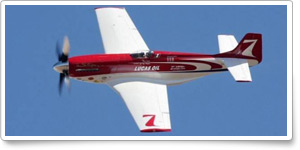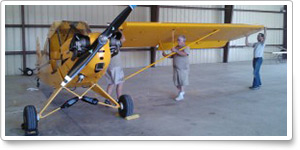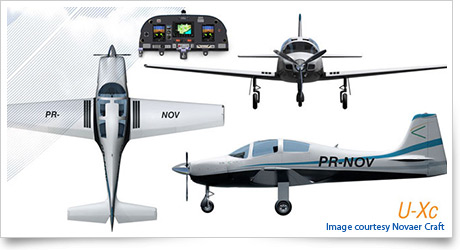GA News Hawker’s T-6 trainer learns to attack Hawker Beechcraft’s T-6A Texan began life as a trainer, but has reversed its letters to become the AT-6 bad boy of the ground attack industry. A successful third round of testing shows that the former student plays well with existing weapons systems including .50-caliber guns, bombs, and rockets. The company hopes its successes on the testing ranges boost chances of winning a U.S. Air Force contract, and continue to attract nations hungry for economical defense systems. Read more >> AV8RS: New teen membership tops 950 What’s it like to look down from the middle of a barrel roll and see eight other airplanes trailing smoke in the world’s largest airshow team? How does one airplane fly through the night on solar energy? The first issue of AOPA’s AV8RS e-newsletter, geared toward enthusiasts ages 13 to 18, offers answers. The new AV8RS program, which offers free youth memberships to teens, has grown to nearly 1,000 members. Want to share your passion for aviation? Encourage someone you know to become an AOPA AV8R. Read more >> 'Strega' captures Gold at Reno—again  Steve Hinton of Chino, Calif., was the fastest piston-aircraft pilot at the 2012 National Championship Air Races in Reno, Nev., Sept. 12 through 16. Hinton won the Unlimited class's Breitling Gold race flying Strega, a modified P-51D Mustang, at a speed of 477.523 mph. Hinton has won the Unlimited class each year since he began racing Strega in 2009, repeating the feat in 2009 and 2010 as well. There was no championship race in 2011, when the event ended early after a crash during the Unlimited Class qualifying round killed the pilot and 10 spectators. Read more >> Steve Hinton of Chino, Calif., was the fastest piston-aircraft pilot at the 2012 National Championship Air Races in Reno, Nev., Sept. 12 through 16. Hinton won the Unlimited class's Breitling Gold race flying Strega, a modified P-51D Mustang, at a speed of 477.523 mph. Hinton has won the Unlimited class each year since he began racing Strega in 2009, repeating the feat in 2009 and 2010 as well. There was no championship race in 2011, when the event ended early after a crash during the Unlimited Class qualifying round killed the pilot and 10 spectators. Read more >> NASA high flyer tests new technology A repurposed U-2, designated the ER-2 for operations with NASA, is launching missions over the East Coast to study clouds and vegetation using instruments designed for eventual satellite deployment. The ER-2 will be sharing an airfield, and perhaps some airspace, with Global Hawk unmanned aircraft systems currently hunting Atlantic hurricanes. Read more >> HondaJet designer recognized for ‘pioneering’ effort HondaJet designer and Honda Aircraft Co. CEO Michimasa Fujino was honored for advancing aviation design with a “pioneering” over-the-wing engine mount, joining a select group of aircraft designers recognized by the American Institute of Aeronautics and Astronautics. The 2012 Aircraft Design Award is considered by many the most prestigious of its kind. The much-anticipated aircraft is slated to begin production this year, with certification expected in 2013. Read more >> Aviation groups, volunteers receive public benefit awards The Lightspeed Aviation Foundation has been honored in Washington, D.C., for its work to promote growth of the pilot population and advance aviation education. Since its inception in 2010, Lightspeed has contributed more than $250,000 to aviation charities, said an organization news release. Read more >> Heathrow replacement a floating airport?  An architectural firm is pitching a design for a sprawling international airport in London, able to serve 150 million passengers a year—on water. The concept, similar to other proposals pitched with varying degrees of connection to land, is the most futuristic-looking to date, though it must survive competition, and opposition from anxious neighbors. The American architectural firm Gensler envisions replacing Heathrow with a set of floating platforms anchored in the Thames Estuary, connected to runways about 16,000 feet long. Read more >> An architectural firm is pitching a design for a sprawling international airport in London, able to serve 150 million passengers a year—on water. The concept, similar to other proposals pitched with varying degrees of connection to land, is the most futuristic-looking to date, though it must survive competition, and opposition from anxious neighbors. The American architectural firm Gensler envisions replacing Heathrow with a set of floating platforms anchored in the Thames Estuary, connected to runways about 16,000 feet long. Read more >>  Reporting Points: Strange but true Reporting Points: Strange but true In separate incidents at Chicago Rockford International Airport, migrating swallows collided with jets linked to Oprah Winfrey and House Speaker John Boehner. Find out more in the latest installment of “Strange but true general aviation news.” FAA seeks to supersede PA-31 exhaust system AD The FAA has issued a notice of proposed rulemaking to supersede an airworthiness directive (AD) applicable to all Piper PA-31, PA-31-325, and PA-31-350 airplanes that requires detailed repetitive inspections of exhaust system downstream of turbochargers, and repair or replacement of parts as necessary. The proposed AD would expand inspections to include the entire exhaust system. Members may submit comments on the proposed AD by Nov. 2. Dimple aerodynamics: A hole in one? Erik Miller was still in high school when he convinced Wichita State University to give him wind tunnel time to test a theory that golf balls can help airplanes fly better. The results of that effort were just published in the Journal of Aircraft, making Miller—also a private pilot—a student who stands out. Read more >> AD issued for Piper stabilator-horn The FAA has issued a final rule adopting an airworthiness directive (AD) requiring replacement of stabilator horn assemblies and/or repetitive inspections of the assemblies for corrosion or cracks on certain Piper Aircraft PA-24, PA-24-250, and PA-24-260 airplanes. The AD, prompted by reports of developing cracks, is effective Oct. 22.  Reporting Points: A friend overhead Reporting Points: A friend overhead As the occupants of a sinking Cessna 185 floatplane awaited rescue off the California coast, a passing aircraft stopped to relay messages from the downed craft. Read more >>  Hover Power: Transverse flow effect Hover Power: Transverse flow effect When a helicopter starts to move forward from a hover, one aerodynamic condition that occurs is transverse flow effect. This condition involves a differential airflow between the front and rear parts of the rotor system. Read more >>  AOPA Live This Week: RV aerobatics, Phenom 100 updates Check out formation aerobatics in Van's RV-4s, learn why the FAA budget is still in jeopardy, take a closer look at the new Van's RV-14 and updates to the Phenom 100, and find out what Palm Springs has to offer the nonpilots at AOPA Aviation Summit. AOPA Live This Week, Sept. 20. For daily news updates, see AOPA Online. AOPA Aviation Summit Summit advance registration extended to Oct. 1 The early registration discount for AOPA Aviation Summit Oct. 11 through 13 has been extended to Oct. 1. Register by then to receive special offers and discounts from Palm Springs. Read more >> Hone your IFR skills Flying IFR is a dynamic undertaking—and not just because of the weather. Satellite-based navigation is changing the routes IFR pilots can fly and the approaches available at the destination. Those new options and capabilities are changing the appearance and content of the charts IFR pilots rely on—not to mention the profusion of information increasingly available to assess the weather. Find out how to keep your knowledge and skills up to date at AOPA Aviation Summit. Read more >> Tom Haines helps lucky member buy the perfect plane Want AOPA Editor in Chief Tom Haines to personally walk you through the aircraft buying process? He’s looking to do just that at AOPA Aviation Summit. Read more >> For more information on AOPA Aviation Summit, see the website. Safety & Proficiency  IFR Fix: Navigating a legacy IFR Fix: Navigating a legacy An old-school flight instructor—sharp as a tack landing a taildragger in a crosswind, but out of his element flying in the system—radioed approach one morning to report that he was “five miles east of the VOR, tracking inbound.” Had Captain Rustic gone techno? No, those cone-in-a-circle VOR installations made fine visual checkpoints, he later explained. For many of today’s pilots who entered the instrument environment training in aircraft equipped with two nav/coms, marker beacons, and maybe an ADF, the satellite-based future air traffic system—NextGen—remains an elusive idea, notwithstanding its overall 2020 target date. Read more >> Fatal haste The crucial first step toward saving time is often to slow down. In flight, hurry can be lethal. A Cessna 182 impacted terrain July 24, 2011, near the top of a 3,100-foot hill near the north end of Alaska's Douglas Island, killing both pilot and passenger. According to GPS flight-track data, the aircraft took off from Hoonah at 6:28 a.m.; the passenger had a 7:28 a.m. flight from Juneau International Airport about 31 nautical miles away. A handheld GPS unit found in the wreckage held a pre-stored flight plan from Hoonah to Juneau—but not the international airport. Read more in this special report from the Air Safety Institute. Should you go to standby mode to change transponder codes? When changing transponder codes, some pilots recommend switching your transponder to standby mode before making any changes. While this procedure helps avoid the possibility of inadvertently entering an emergency code, does this method impact ATC, and is it a good idea? We posed this question to air traffic controllers, and they responded. Listen to ATC’s recommended way of changing transponder codes in this segment of the Air Safety Institute’s Ask ATC.  That time again? Search for AMEs in AOPA database That time again? Search for AMEs in AOPA database When it’s time for your next flight physical, AOPA’s aviation medical examiner database can help you find the right AME. Pilots can search by name or distance from a specific location, and find out whether a doctor is a senior AME who can give first class medical exams. You can even find out whether the doctor is a pilot. Runway rules 101  As pilots, we tend to focus the majority of our attention to the challenges that await us in the skies. But sometimes the most demanding part of a flight is actually getting to and from the runway. Don’t arrive at your destination only to get lost at the airport! Use the Air Safety Institute’s Runway Safety Flash Cards to better understand runway signage and markings. The front of each card displays an airport sign or pavement marking, while the back provides a description and information on the required pilot action. As pilots, we tend to focus the majority of our attention to the challenges that await us in the skies. But sometimes the most demanding part of a flight is actually getting to and from the runway. Don’t arrive at your destination only to get lost at the airport! Use the Air Safety Institute’s Runway Safety Flash Cards to better understand runway signage and markings. The front of each card displays an airport sign or pavement marking, while the back provides a description and information on the required pilot action.  Leading Edge: Get me to the game on time Leading Edge: Get me to the game on time A recurring accident theme is the use of general aviation aircraft to get to sporting events. Pilots are often traveling with friends or family, so there is a social commitment of delivering passengers to a special, possibly prestigious, event. Tickets are pricey and often hard to get, adding to the pressure of an irreplaceable loss if the trip is canceled or delayed. A recent fatal accident involved five people returning from a baseball game. Read more >> Flight Instructor Refresher Clinics | Air Safety Institute Safety Seminars | Sept. 22 and 23 Sacramento, Calif. Colorado Springs, Colo. Richmond, Va. | Oct. 6 and 7 Indianapolis, Ind. Corpus Christi, Texas | Oct. 13 and 14 Windsor Locks, Conn. Fort Lauderdale, Fla. Nashville, Tenn. | Oct. 20 and 21 Columbia, S.C. | For a complete schedule, see AOPA Online. Can’t make it in person? Sign up for the CFI Refresher Online. | Sept. 24 Mesa, Ariz. Fort Worth, Texas Salt Lake City, Utah | Sept. 25 Tucson, Ariz. Pocatello, Idaho Addison, Texas | Sept. 26 Boise, Idaho El Paso, Texas | Sept. 27 Albuquerque, N.M. | Topics vary—for details and a complete schedule, see AOPA Online. | ADVOCACY Coalition lauds new Avgas Fuels Program Office The FAA has created a new Fuels Program Office in response to a letter from the General Aviation Avgas Coalition, which had urged funding an unleaded avgas program. The office will be responsible for “providing technical expertise and strategic direction in the planning, management, and coordination of activities related to aviation fuels.” Read more >> Join the Airport Support Network today Ensuring the health and vitality of your airport is up to you—incompatible development and economic and political pressures can restrict your flying. Every day, close to 2,500 Airport Support Network (ASN) volunteers work with AOPA headquarters to help save their airports, but we need more. Below is a link to a list of the airports where an ASN volunteer could make a difference. To nominate yourself or an associate to be a volunteer, visit AOPA Online. To learn more about the Airport Support Network, visit ASN Online.  AOPA Now: Speaking up for GA in Alaska AOPA Now: Speaking up for GA in Alaska For those of us who live in the “Lower 48,” Alaska can sometimes feel a world away. But AOPA President Craig Fuller loves to visit it, not least because so many of the residents are involved in general aviation. Fuller was part of an event with Sen. Mark Begich of Alaska, as well as Pete Bunce of the General Aviation Manufacturers Association, Tom Hendricks of the National Air Transportation Association, and Ed Bolen of the National Business Aviation Association. Read more >>  VFR: How to pack a Cub VFR: How to pack a Cub  On a recent trip to work on legislative issues and promote general aviation in Nebraska and Iowa, Central Southwest Regional Manager Yasmina Platt witnessed a feat: With every piece measured to the last detail, airshow performer Greg Koontz’s team disassembled and packed a Piper Cub in a trailer in 30 minutes. Check out the photos and a rundown of the weekend’s events. Platt also reflects on a decade of flying in this week’s Views From the Regions blog. On a recent trip to work on legislative issues and promote general aviation in Nebraska and Iowa, Central Southwest Regional Manager Yasmina Platt witnessed a feat: With every piece measured to the last detail, airshow performer Greg Koontz’s team disassembled and packed a Piper Cub in a trailer in 30 minutes. Check out the photos and a rundown of the weekend’s events. Platt also reflects on a decade of flying in this week’s Views From the Regions blog. Member Benefits ‘What, me worry?’ Alfred E. Neuman, the slightly manic icon of Mad magazine fame, brought this phrase into common usage. He was probably not a pilot. “It will never happen to me, so why should I worry?” As aviators we do not approach our flights in such cavalier manner; no, we plan, preflight, and stay ahead of the airplane and any eventuality the fates throw at us. Read more >> Hurricane preparedness: Keeping you covered With hurricane season under way, AOPA members who live or plan to travel in hurricane-prone areas should have a plan to relocate their aircraft in the event of a storm. Read more >> Membership offers mobile flight planning AOPA members can get airport directory information, aviation weather, and flight planning with auto-routing capabilities on iPhone or Android smartphones with FlyQ Pocket, part of the association’s suite of mobile applications. Members with Windows Mobile or BlackBerry devices can still access airport information with AOPA Airports apps powered by WingX. The apps are free with membership. AOPA Career Opportunities Ever dream of turning your passion for aviation into a career? We’re looking for a director of legislative affairs, director of media relations, major gifts officer, accounts payable technician, aviation technical generalist, and Web graphic designer. To learn more about other AOPA career opportunities, visit AOPA Online. Community Picture Perfect AOPA’s online photo gallery allows you to upload your own aviation photography as well as view, rate, and comment on others’ photos. Your favorite aviation images from AOPA Pilot are still available online through this new gallery. Take a look, and submit your own photos!  |  Forums: When to find a new CFI Forums: When to find a new CFI A student pilot soloed twice, but is having problems scheduling with the CFI. Two other schools in the area offer better availability, but are more expensive and require training in a new aircraft. Should this student be patient with the current school, or change to a new school completely? Share your thoughts >>  Follow AOPA Online Follow AOPA Online  Become a fan Become a fan  Subscribe to the RSS feed Subscribe to the RSS feed | | Engage in Aviation Check out user-submitted events from your region. To include an event or to search all events in the calendar, visit AOPA Online. AOPA does not endorse the events listed below, nor have ePilot editors edited the submissions. AOPA assumes no responsibility for events listed. |  My Membership My Membership | QUIZ ME! Here’s a question asked by an AOPA member who contacted our aviation services staff through the AOPA Pilot Information Center. Test your knowledge. Question: My airport has extensive glider operations mixed with powered aircraft. When does a glider have the right of way over the other aircraft? Answer: According to FAR 91.113, Right-of-way Rules, the gliders would have right of way over the powered aircraft. There is one exception to this—when an aircraft is in distress, that aircraft would have right of way over all other aircraft regardless of category. However, a glider does have to yield to one aircraft category: A balloon has the right of way over any other category of aircraft, so a glider would need to yield to a balloon. For more information, read this story about right of way. Got a question for our aviation services staff? The AOPA Pilot Information Center is a service available to all members as part of the annual dues. Call 800/USA-AOPA (800/872-2672), or email to [email protected]. | |  | |  Patronize airport businesses. Successful businesses at your airport play a vital role in the financial viability of the airport itself. Local governments that own airports are more likely to protect them and make improvements if they see them as the center of a thriving community. Patronize airport businesses. Successful businesses at your airport play a vital role in the financial viability of the airport itself. Local governments that own airports are more likely to protect them and make improvements if they see them as the center of a thriving community.  Remember to use your AOPA credit card to earn double points on select aviation purchases—every purchase supports general aviation at no additional cost to you! Don’t have the AOPA credit card? Apply today and show your passion for GA. Remember to use your AOPA credit card to earn double points on select aviation purchases—every purchase supports general aviation at no additional cost to you! Don’t have the AOPA credit card? Apply today and show your passion for GA. | |  | |
 AOPA Now: Speaking up for GA in Alaska
AOPA Now: Speaking up for GA in Alaska VFR: How to pack a Cub
VFR: How to pack a Cub On a recent trip to work on legislative issues and promote general aviation in Nebraska and Iowa, Central Southwest Regional Manager Yasmina Platt witnessed a feat: With every piece measured to the last detail, airshow performer Greg Koontz’s team disassembled and packed a Piper Cub in a trailer in 30 minutes. Check out the photos and a rundown of the weekend’s events. Platt also reflects on a decade of flying in this week’s Views From the Regions blog.
On a recent trip to work on legislative issues and promote general aviation in Nebraska and Iowa, Central Southwest Regional Manager Yasmina Platt witnessed a feat: With every piece measured to the last detail, airshow performer Greg Koontz’s team disassembled and packed a Piper Cub in a trailer in 30 minutes. Check out the photos and a rundown of the weekend’s events. Platt also reflects on a decade of flying in this week’s Views From the Regions blog.










